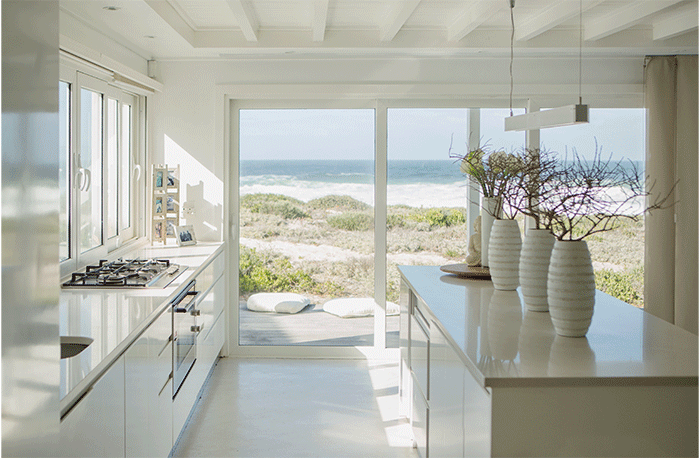Creating the Sixth Sense of Design in Kitchens and Baths

May 12, 2023
This article was originally published on May 12, 2023; it was updated on May 23, 2023.
Kitchen and bath interior design projects should strive to create an elevated tactile experience that evokes a sense of comfort, delight and sophistication. When our senses are pleased, it eases us into a more relaxed mindset. Scientifically, our experience of the world (and ourselves within the world) is influenced by how our brains and bodies process and integrate sensory input. So, the more pleasing to the senses that we can make a space, the better for our well-being.
But I would argue that beyond the five senses of our bodily experience, there is a sixth sense of design must consider: ease. Designing for efficiency, ease of use and maintenance impacts the way our senses interact with objects and spaces, which makes a positive impact on our entire sensory experience.
The Sixth Sense of Design: All the Feels in the Kitchen
It’s well known that smooth countertops and backsplashes in luxurious materials like marble or quartz will elevate the look and feel of any kitchen, while high-quality faucets and fixtures make for an enjoyable bathing experience. But this is 2023, and there are many fascinating, functional, innovative and beautiful options to improve our sensory design – many of which are sustainability minded too – that benefit our overall sense of well-being.
Induction cooktops are all the rage as a sustainable alternative to gas. But they also bring added benefits like minimal visual footprints and ease of cleaning thanks to their flat surfaces. Now, manufacturers like Bertazzoni are taking induction innovation a step further, with seamlessly integrated down-draft hoods (saving you from smells and smoke while cooking and cutting out the need for an overhead hood), auto-detecting and responsive heat footprint sensors and instant heating and cooling of cook zones.
Electric food composters are a wonderful alternative to countertop compost bins, which can gather unpleasant odors and attract insects. The electric versions can complete in a small footprint indoors what normally requires a compost heap outdoors. These handy gadgets turn bulky food waste into small, dry, nutrient-dense compost material that can enrich your soil outdoors or houseplants inside.
Kitchen storage is ever evolving, and more built-in concepts are in high demand. Large, counter-depth cabinets with built-in outlets and pull-up or down doors are a great way to store smaller appliances without having to move them each time you want to use them – within arm’s reach but hidden from eyes (and protected from dust or grease) the rest of the time. Slide-out cabinets with custom shelving are improving accessibility and space-consciousness. And speaking of doors, I predict less textured cabinet doors with trim, being traded more in favor of smooth surfaces and clean lines – which are both easier on the eyes and easier to clean.
Outdoor kitchens started gaining momentum during and following the pandemic lockdown of 2020, but I predict this trend will keep growing and expanding. They make entertaining during warmer months more seamless, keep smoke and lingering cooking odors out of the house and make cleaning a breeze. The sensory experience of spending more time outdoors does wonders for our sense of well-being.
Simplicity in the Bathroom
In this space, there are several exciting sensory-enhanced or enhancing advancements coming to market or gaining momentum with consumers.
Sensor-based smart showerheads can save water without sacrificing water pressure and flow rate like the Oasense Reva. With this technology, water is automatically reduced once cold water is purged from the pipe and whenever users take a step out of the stream to lather. This way, you don’t have to sacrifice comfort or convenience for sustainability.
Anywhere we can introduce warmth in a bathroom elevates the sensory experience, so I’m happy to see heated floors, toilet seats and bidets growing in popularity. These are quite efficient and elegant solutions that enhance comfort and sustainability – they hit all the marks!
Specialty sensory-enhancing features in bathrooms like saunas, cold plunge tubs, steam showers or pressure jets are all timeless and more accessible than ever. People are embracing self-care at home in new ways, and these elements’ ties to wellness simply cannot be disputed.
Similarly to the rise in smooth cabinets in the kitchen, smoother surfaces prevail in the bathroom as well. The less grout we use between tile, the easier the space is to clean and the more serene it appears to the eyes and feels to the touch.
Good design is so much more than what simply meets the eye. It’s the entire sensory experience, and it goes beyond sight, smell, taste, touch and sound. It’s also about efficiency, accessibility and ease of maintenance, because those affect our sensory experience, too. These are especially important and impactful considerations in the kitchen and bath, two spaces that are key to our tactile and sensory experience at home.
Photo: Paul Bradbury/KOTO/Adobe Stock
Photo: By Laurence Carr, CEO and creative director, laurencecarr.com
More News
April 16, 2024 | Awards & Events
Kips Bay Boys & Girls Club Honors Ellie Cullman, Cosentino
April 15, 2024 | Trends & Inspirations
Houzz: Renovation Slows, but Design Pros Optimistic
April 15, 2024 | KBB Collective
Outdoor Kitchen Style: Maximizing Style & Functionality in Small Spaces
April 14, 2024 | Awards & Events
Coverings 2024 Announces 10th Class of Rock Stars
April 13, 2024 | Awards & Events
ICFF Announces 2024 Programming and Features
April 2, 2024 | Sponsored
Whirlpool Corp. Brings Purposeful Innovation Home